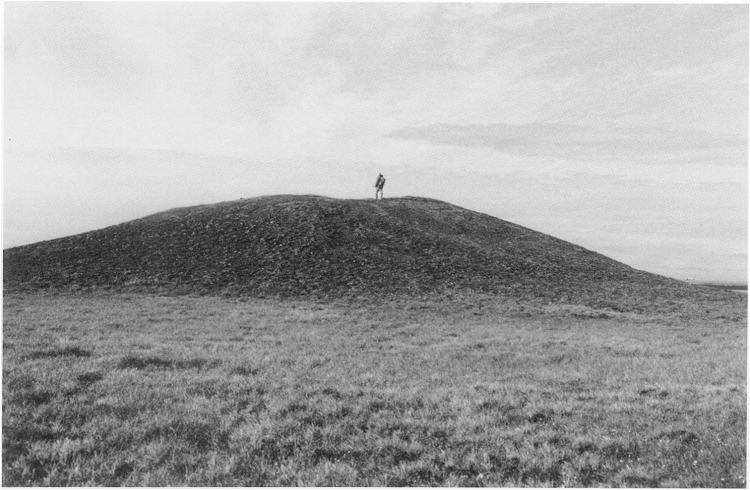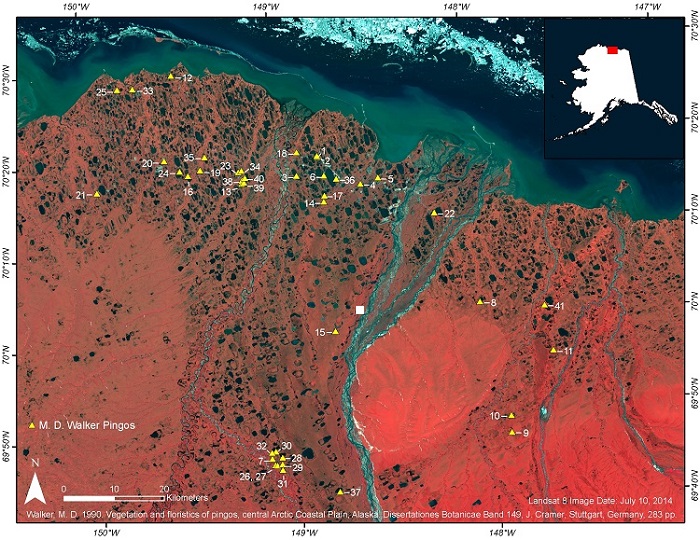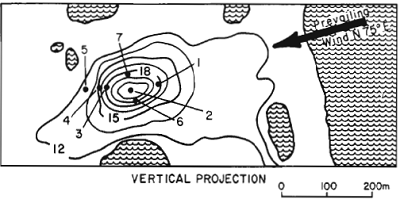Documentation Revision Date: 2018-12-31
Data Set Version: 1
Summary
The pingos are ice-cored, dome-shaped mounds found in permafrost regions and are an important component of the Alaskan central Arctic Coastal Plain landscape. A complete list of plant species was obtained for each plot. The vegetation pattern is complex due to differences in slope angle, slope aspect, effects of wind, disturbance by animals, site stability, and deposition of snow, as well as meso- and macroscale patterns related to the coastal climatic gradient and substrate variation.
There are two data files with this data set in comma-separated (.csv) format.

Figure 1. A typical pingo, Prudhoe Bay, Alaska. This feature is 7 m high and has a basal diameter of 110 m (Walker, 1990).
Citation
Walker, M.D. 2018. Arctic Vegetation Plots from Pingo Communities, North Slope, Alaska, 1984-1986. ORNL DAAC, Oak Ridge, Tennessee, USA. https://doi.org/10.3334/ORNLDAAC/1507
Table of Contents
- Data Set Overview
- Data Characteristics
- Application and Derivation
- Quality Assessment
- Data Acquisition, Materials, and Methods
- Data Access
- References
Data Set Overview
Vegetation species and vegetation plot data were collected in 1983 from 293 study plots on 41 pingos within the Arctic Coastal Plain of the North Slope of Alaska. The pingos were located in the Kuparuk, Prudhoe Bay, Kadleroshilik and the Toolik River areas. Specific attributes include dominant vegetation, species, and cover, soil pH, moisture, and physical characteristics of the plots.
Pingos are ice-cored, dome-shaped mounds found in permafrost regions and are an important component of the Alaskan central Arctic Coastal Plain landscape. The pingo vegetation is a complex vegetation pattern which is the result of differences in in slope angle, slope aspect, effects of wind, disturbance by animals, site stability, and deposition of snow. In addition to these microscale controls, meso- and macroscale patterns related to the coastal climatic gradient and substrate variation are also reflected on pingos.
Sampling was opportunistic. Circular plots were 12.5 m2 and were permanently marked. Each pingo was assigned a name and number unless already named on US Geological Survey Maps.
The Pre-ABoVE vegetation plot datasets were curated to create the Alaska Arctic Vegetation Archive (AVA-AK; Walker et al. 2016b, Walker 2013). The AVA-AK is a regional database that is part of the larger Arctic Vegetation Archive (Walker 2016a, Walker et al. 2013, Walker and Raynolds 2011). The database contains vegetation plots from homogeneous plant communities with tables of cover or cover-abundance scores for all species and accompanying environmental site data. Field data were collected using Braun-Blanquet, US National Vegetation Classification protocols, or comparable methods.
Project: Arctic-Boreal Vulnerability Experiment (ABoVE)
The Arctic-Boreal Vulnerability Experiment (ABoVE) iis a NASA Terrestrial Ecology Program field campaign that will take place in Alaska and western Canada between 2016 and 2021. Climate change in the Arctic and Boreal region is unfolding faster than anywhere else on Earth. ABoVE seeks a better understanding of the vulnerability and resilience of ecosystems and society to this changing environment.
Acknowledgements:
These data files were edited by Donald A. Walker, Amy L. Breen and Lisa A. Druckenmiller at the University of Alaska Fairbanks' Alaska Geobotany Center and obtained via the Arctic Geoecological Atlas (http://arcticatlas.geobotany.org/), which provides access to existing Arctic vegetation plot and map data in support of the ABoVE campaign.
Data Characteristics
Spatial Coverage:
ABoVE Grid Location: Ahh1Avv0.Bh2Bv2
Spatial Resolution: Point resolution
Temporal Coverage: Summer field seasons in 1983
Temporal Resolution: Each plot was sampled once
Study Area: (All latitude and longitude given in decimal degrees)
| Site | Westernmost Longitude | Easternmost Longitude | Northernmost Latitude | Southernmost Latitude |
|---|---|---|---|---|
| Arctic Coastal Plain, North Slope, Alaska | -149.949 | -147.657 | 70.49962 | 69.71159 |
Data File Information
There are two data files with this data set in comma-separated (.csv) format.
Table 1. Data files
| Data File Name | Description |
|---|---|
| pingos_environmental_data.csv | Comprehensive set of environmental characterization data for pingo research plots including the descriptive site factors |
| pingos_species_data.csv | The estimated percent land cover by species per plot |
| Companion files | Description |
| pingos_veg_plots_report.pdf | Document which provides details of the research in.pdf format |
| scalar_value_tables_pingos_env_data.pdf | Document which provides the tables of scalar values and codes used to estimate and describe environmental variables. This pdf is provided for user’s convenience. These tables were taken from the companion file above. |
| Pingo_Veg_Plots.pdf | A pdf of this guide document |
Table 2. Variables in the file pingos_environmental_data.csv
Much of the data were described and estimated using scalar values and codes. Refer to the companion file scalar_value_tables_pingos_env_data.pdf for these values and codes.
Data not provided are represented as -9999.
| Column number | Variable | Units/format | Description |
|---|---|---|---|
| 1 | date | yyyy | Year plots were investigated |
| 2 | pingo_number | numeric | Pingo number as provided by the author |
| 3 | plot_number | numeric | Plot number |
| 4 | author_plot number | numeric | Pingo number and plot number at that pingo, listed as #_# |
| 5 | study_area | Areas where plots and pingos were located: Prudhoe Bay, Toolik River, Kadleroshilik, or Kuparuk | |
| 6 | pingo_name | Name assigned to pingo unless already assigned by the US Geological Survey (USGS) | |
| 7 | latitude | decimal degrees | Plot latitude provided in decimal degrees. |
| 8 | longitude | decimal degrees | Plot longitude provided in decimal degrees. |
| 9 | plant_community | Plant community name | |
| 10 | general_landscape_unit | code | Code (number) used to describe the general landscape. |
| 11 | slope_angle | degrees | Slope angle of the plot in degrees |
| 12 | aspect | degrees | Aspect in degrees |
| 13 | slope_position | code | Plot-slope position |
| 14 | exposure_wind | scalar | Exposure of individual plots to winds estimated using a scalar value. |
| 15 | thaw_depth | cm | Thaw depth in cm |
| 16 | snow_duration | scalar | Snow cover and duration estimated using the ordinal scale of 1-10 |
| 17 | surface_stability | scalar | Surface stability estimated using the ordinal scale of 1-10 |
| 18 | cryoturbation | % | Cryoturbation (0-100%) estimated using the ordinal scale of 1-10, with 0% being 1, and 75-100% being 10 |
| 19 | microrelief_ht | cm | Microrelief height |
| 20 | pH | Soil pH | |
| 21 | soil_type | code | Code (number) used to describe the soil:1-13 |
| 22 | soil_or_site_moisture | scalar | Estimated soil or site moisture. Note that there is uncertainty as to whether this is soil or site moisture according to the data provider. Refer to Tables 9 and 13 in the companion file for the scalar values |
| 23 | plot_size | m2 | Plot size: 12.5 m2 |
| 24 | microsite | Describes releve location | |
| 25 | soil_texture | Soil texture as described in notes |
Table 3. Variables in the file pingos_species_data.csv
This file provides species cover classes by percent.
| Column number | Column header | Description |
|---|---|---|
| 1 | PASL_taxon_scientific_name | Current nomenclature according to the Panarctic Species List (PASL) |
| 2 | PASL_taxon_scientific_name_author | Current nomenclature according to the Panarctic Species List (PASL) with the data authors name |
| 3 | dataset_taxon | Data set taxonomy |
| 4-296 | TURBOVEG_plot_accession_number and dataset_plot_number_author | Two rows of 293 column headers. The first row is TURBOVEG accession numbers. Column headers= 10632-10924. The 2nd row are the plot numbers as named in the original data set by pingo number_plot number; column headers= numbers 1_1 to 41_16 (nonsequential #s). The data are species cover classes by percent* |
* Data file notes:
Values greater than 0.5 but less than 1 percent were assigned the value 0.7.
Values less than 0.5 but greater than 0 percent were assigned the value 0.3 percent.
In two instances, taxa were lumped into a single taxon in the PASL:
1) Cetraria islandica (Cetraria islandica and Cetraria islandica crispiformis)
2) Cladonia fimbriata (Cladonia fimbriata and Cladonia chlorophea).
Table 4. Example data from the file pingos_species_data.csv
| TURBOVEG_plot_accession_number | 10632 | 10633 | 10634 | ||
| dataset_plot_number_author | 1_1 | 1_2 | 1_3 | ||
| PASL_taxon_scientific_name | PASL_taxon_scientific_name_author | dataset_taxon | |||
| Abietinella abietina | Abietinella abietina (Hedw.) Fleisch. | Thuidium abietinum | 0 | 0 | 0 |
| Achillea millefolium subsp. borealis | Achillea millefolium subsp. borealis (Bong.) Breitung | Achillea borealis | 0 | 0 | 0 |
| Alectoria ochroleuca | Alectoria ochroleuca (Hoffm.) Massal. | Alectoria ochroleuca | 0 | 0 | 0 |
Application and Derivation
These data could be useful to climate change studies.
Quality Assessment
Data were entered into the CYBER computer at the University of Colorado for analysis. At each stage, a series of checks was used to ensure accuracy against the field notes. Refer to the comp file pingos_veg_plots_report.pdf for additional information.
Data Acquisition, Materials, and Methods
Site characteristics
The study area was within the Arctic Coastal Plain of the North Slope of Alaska, in the Kuparuk, Prudhoe Bay, Kadleroshilik, and Toolik River areas. Pingos are ice-cored, dome-shaped mounds found in permafrost regions and are an important component of the Alaskan central Arctic Coastal Plain landscape. They may be as high as 50-m, with basal diameters exceeding 1-km, but on the coastal plain most are between 5 and 20-m high, with diameters between 70 and 400-m. Pingos are not evenly distributed across the coastal plain but are abundant in areas with sand and gravel substrates.
The pingo vegetation is primarily dominated by Dryas integrifolia although it is not present in all stand types. The complexity of the vegetation pattern is a result of differences in in slope angle, slope aspect, effects of wind, disturbance by animals, site stability, and deposition of snow. In addition to these microscale controls, meso- and macroscale patterns related to the coastal climatic gradient and substrate variation are also reflected on pingos.
Soils on the pingos are Mollisol, Inceptisol, Entisol, and Histosols. Distribution of the soil types was related to microsite and regional gradients (Walker, 1990).
The pingos in the study are described as (1) steep-sided, with relatively steep side slopes, usually between 10 and 30-m, found exclusively within the boundaries of recognizable drained thaw- lake basins, and presumed to be a result of the formation of permafrost in thawed, saturated, coarse sediments following lake drainage; or (2) broad-based, having a greater total volume and gentler side slopes than the steep-sided pingos (Walker et al., 1991). Nine pingos in the study area were considered to be the broad-based type.
Methods
A total of 293 plots were located on 41 pingos in the four areas listed above. Final latitude and longitude for the pingos were estimated in 2014 using topographic maps and a project mylar overlay, color infrared aerial photographs, and Google Earth.

Figure 2. Locations of the 41 pingos in the study areas of the Arctic Coastal Plain (Walker, 1990).
Sampling was opportunistic. Circular plots were 12.5-m2 and were permanently marked. Each pingo was assigned a name and number unless already named on USGS Maps.
Plots were located in up to nine different locations on the pingos including:
a) bottom of snowbank (40 plots)
b) middle snowbank (45 plots)
c) ENE side of the pingo (36 plots)
d) north slope of pingo (41 plots)
e) south slope of pingo (45 plots)
f) summit of pingo (41 plots)
g) WSW slope of pingo (39 plots)
h) very late lying or permanent snowbed (4 plots)
i) frost boil (1 plot).
One plot had insufficient location information.

Figure 3. Topographic map of Pingo 6 (Angel) with a 1.5-m contour interval. Seven microsite sampling locations are labeled as (1) ENE wind exposed, (2) summit, (3) dry leeward side snowbank, (4) middle of snowbank on leeward side (well-drained), (5) bottom of snowbank at leeward base of pingo (poorly drained), (6) south slope, (7) north slope. Topographic information from Air Photo Tech 1979 (Walker, 1990).
The plots occurred in seven broad habitat types:
a) zoogenic communities associated with animal dens and bird mounds (50 plots)
b) willow shrub vegetation of riparian areas and warm habitats (8 plots)
c) talus slope, debris and alluvial vegetation (4 plots)
d) deep snowbed vegetation (40 plots)
e) dry to moist dwarf-shrub heath and low-shrub vegetation on acidic nutrient poor substrates (40 plots)
f) dry and mesic dwarf-shrub and graminoid vegetation on non-acidic substrate (133 plots)
g) steppe tundra communities on south facing slopes of pingos (19 plots).
A complete list of plant species was obtained for each plot.
Environmental Plot Data
Most of the environmental plot data were estimated using scalar values and prior information from related publications. Soil pH was determined in the laboratory.
Refer to the companion file pingos_veg_plots_report.pdf for additional information.
This data set was provided by the GINA repository at http://geobotanical.portal.gina.alaska.edu/plot-archive/plot-datasets/33-toolik-lake.
Data Access
These data are available through the Oak Ridge National Laboratory (ORNL) Distributed Active Archive Center (DAAC).
Arctic Vegetation Plots from Pingo Communities, North Slope, Alaska, 1984-1986
Contact for Data Center Access Information:
- E-mail: uso@daac.ornl.gov
- Telephone: +1 (865) 241-3952
References
Walker, M.D., D.A. Walker, K.R. Everett, and S.K. Short. 1991. Steppe Vegetation on South-Facing Slopes of Pingos, Central Arctic Coastal Plain, Alaska, U.S.A. Arctic and Alpine Research 23: 170-188.
Walker, M.D. 1990. Vegetation and floristics of pingos, Central Arctic Coastal Plain, Alaska. Dissertationes Botanicae. J. Cramer, Stuttgart, Germany.